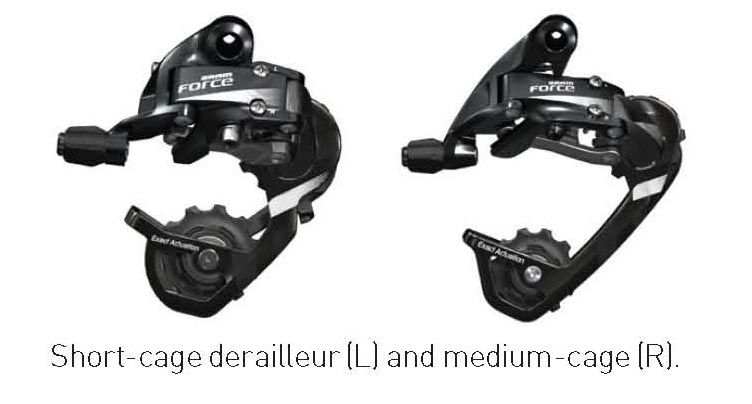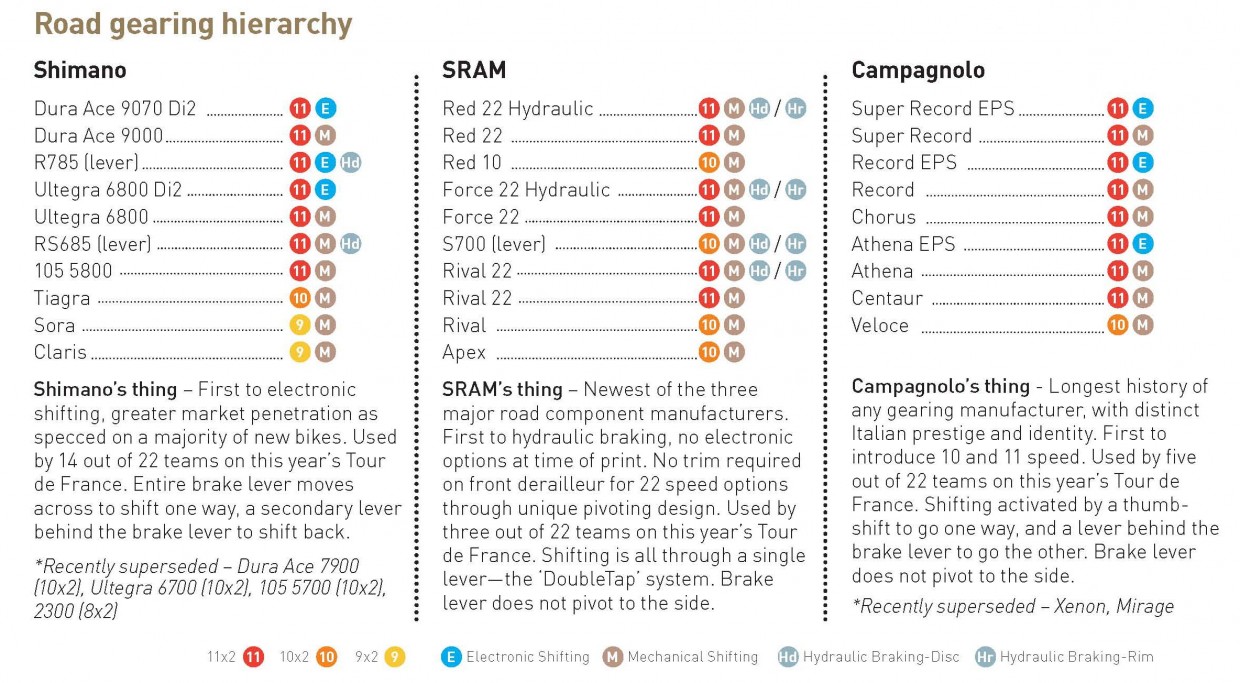Iain Treloar gets geared up to explain the secrets of chains, gears and ratios for road bikes.

Gearing has gone through a number of variations over the past 10 years. On mountain bikes: a wide spread remains king—generally a triple chainring on the front, multiplied by between 7 and 11 gears on the back. Recently, however, this has started trending toward a double, then single front chainring and ultra-wide spread on the back, to get a gearing range that is similar without being quite as broad, whilst saving on weight and reducing the potential for mechanical issues.
On road bikes, the close ratios of the ‘70s and ‘80s settled for a time on a traditional 53/39 tooth double chainring on the front. This has gradually been joined by a couple of friends.
First was a triple chainring on the front; partially a response to a change from the lower cadence road pedalling of the 1990s and earlier, as Lance Armstrong showed his winning ways with a higher cadence that has since become accepted practice (some of his other methods not so much). The triple chainring set-up allowed for the ability to spin a low gear on extremely steep climbs, and, understandably, soon found favour with recreational riders.
The triple chainring started phasing out with the arrival of the compact crankset—a designation not referring to crank length, but the ratios of the chainrings. On road bikes, these usually combine a 50 tooth large ring with a 34 tooth small ring, instead of 53/39. The compact crankset offers easier climbing gears with a negligible difference to high-end speed, unless you are a particularly powerful rider spending a significant proportion of time above 50 km/h—hence why they’re rarely sighted in the pro ranks. They have since become a popular aftermarket adaptation for those riding race-oriented bikes who struggle to stay on top of their gear when climbing.
Cranksets (a catch-all term for both cranks and a set of chainrings) are pricey; chainrings on their own less so, but unfortunately, until recently, changing between a standard and compact set-up meant purchasing a completely new crankset rather than just a pair of chainrings. The reason for this lies in a three letter acronym that causes a world of pain: BCD (Bolt Circle Diameter). Essentially, the point at which the chainrings attach to the crank arms varies, and the compact crank and standard crank were different. In fact, for a time, there were 10 different BCDs that your chainrings might have been, making purchasing new chainrings a pretty unpleasant experience if you weren’t cluey to this.
Happily, last year all three major component manufacturers started standardising the BCD across their own ranges, so you can change from a standard to compact set and back again with a minimum of hassle and inconvenience. Mid-compact cranksets have started to become popular over the last year or two, offering a 52/36 ratio that ostensibly combines the benefits of standard and compact gearing.
So that’s the front end out of the way. What about the back?
It’s complicated back there, as well. If you remain unsatisfied with your gearing range from a compact crankset, the remaining option is to alter your gear ratios at the back. Wide-range gearing options on road bikes were initially cobbled together from mountain bike rear derailleurs and cassettes, which worked
well, but they were heavier and somewhat spoiled the aesthetic appeal of a complete groupset. Most conventional short-cage road derailleurs can handle up to a 28 tooth cog on the back, but any greater than that requires a medium-cage. The longer, lower cage allows the derailleur to shift into the innermost cog on the back without risking damage to the derailleur hanger. Note that a short cage may seem to handle this stretch in the small ring, but a mistaken shift to the big ring could be catastrophic. Mid-cage derailleurs can handle a cassette range from 11-28 up to 11-32.
Most conventional short-cage road derailleurs can handle up to a 28 tooth cog on the back, but any greater than that requires a medium-cage. The longer, lower cage allows the derailleur to shift into the innermost cog on the back without risking damage to the derailleur hanger. Note that a short cage may seem to handle this stretch in the small ring, but a mistaken shift to the big ring could be catastrophic. Mid-cage derailleurs can handle a cassette range from 11-28 up to 11-32.
The first to introduce a wide-range gearing solution for the road market was SRAM with their WiFLi system—a creatively assembled acronym that explains it is Wider range than a triple crankset, Faster shifting and Lighter. Check our review of this system in the April-May 2014 issue.
Shimano are also savvy to the benefits of similar systems. Shimano short-cage derailleurs run up to 28 teeth, after which a mid-cage will be necessary.
Older Campagnolo short-cage derailleurs only go up to 26 teeth, and newer ones will go up to 29 teeth. Campagnolo offer mid-cage derailleurs to give a bit of extra gearing
range, although with cassettes only available up to 30 teeth in a 10 speed or 29 in 11 speed, you won’t be able to get the same low gear as SRAM or Shimano offer. For a greater range than that you’ll need to drop the money on a triple crankset, triple-specific front and rear derailleurs, and shifters.

Chains
Six-eight speed chains are the same, but then it gets a little more complicated. 9 speed chains are specific to 9 speed drivetrains, a pattern that continues with both 10 and 11 speed, with chains becoming almost imperceptibly (but vitally) narrower.
Cassettes and hubs
Shimano and SRAM cassettes are mutually compatible, but how they match up with hubs varies significantly.
6, 7 and 8 speed – Cassettes will fit on the same hub.
9 and 10 speed – Different hub across the board. Note that ten-speed cassettes, despite having an extra cog, are actually slightly narrower than nine-speed cassettes and
require a spacer to fit on the hub.
11 speed – May fit on a 9+10 speed hub, depending on brand. Campagnolo cassettes and their relevant bodies are not cross-compatible to any other brand. Campagnolo
hubs from 9 to 11 speed will fit on the same Campagcompatible cassette body. Campagnolo also make cassette bodies compatible with SRAM and Shimano, but only from 8-10 speed.
Ride On content is editorially independent, but is supported financially by members of Bicycle Network. If you enjoy our articles and want to support the future publication of high-quality content, please consider helping out by becoming a member.

“Campagnolo also make cassette bodies compatible with SRAM and Shimano, but only from 8-10 speed.”
Actually, Campagnolo do make a freehub body compatible for 9-11 speed Shimano/SRAM cassettes, the part number is FH-BUU015X1 for anyone who needs this.
Miche make just about every combination of cassette ratio that you want for most if not all of the manufacturers.
The best thing I’ve done was replaced my rear 9 speed cassette from 11-26t to 12-28t. (Front chain ring 42/50)
You wouldn’t think 1 or 2 extra teeth per ring could make so much difference !
I’ve gone from struggling up hills to cruising with high cadence making my 23km commute much more pleasant.
In fact my up hill speed has actually increased !
This is the best upgrade I’ve done to my bicycle with immediate benefits !